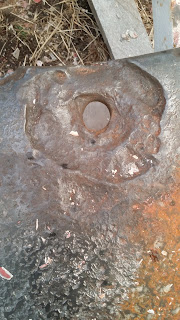The keel needs to be striped down to bare metal before welded repairs can be made. That means all the ablative bottom paint must be removed. All the sealer paint also has to go. Those are the easy layers, beneath them is the fairing compound or body filler. It is difficult to remove but the worst is beneath it. The corrosion itself is the worst. Some iron oxides are even harder than steel, so removing them can be very difficult.
If you are striping a keel, and you are considering using sand paper to remove the filler, even on an electric or pneumatic sander. DON'T. It'll work. Eventually. But only after filling many, many sheets of paper. And it's Very Slow.
Looking closely at the top picture on the page, and the picture immediately above this paragraph you can see the results of wire brushing the filler. With a knotted wire wheel on an angle grinder the filler flies off in big clouds of nastyness. It's faster than sanding but even messier. In this case faster is relative. It's still not very fast.
What worked fastest was hammer and chisel. As in this picture, where it was already bubbling up from corrosion beneath, I could remove large chunks quickly (yes still relative, but truely quickly.)
Once the filler was removed, or at least most of it was removed, it was on to removing the corrosion.
I considered trying electrolysis to remove the rust, but I found myself daunted at the idea of trying to form, then electrify a bathtub sized body of water, without actually spending enough to buy a plastic livestock watering tub. In hindsight, that may have been a good way to go about it.
Remember that picture at the top of this post. Here are two more, showing the same thing I want to point out. See how shiny the metal parts are? That's polished with a knotted wire wheel, or knotted wire cup, on an angle grinder. It polished up nicely, too bad it's still a layer of black iron oxide, and not bare metal.
I also tried an inexpensive Harbor Freight sand blaster, it didn't do much. I'm not sure if the problem with insufficient air volume or pressure, or the wrong media, or a non-functional product or user error. I suspect the first two issues.
For areas like the holes in the picture at the right a hammer and chisel, those trusty friends, did pretty well, at least at getting the majority of the rust out.
What I found to work best, at getting down to bare metal was 36 grit flap sanding discs like this:
The problem with them is that they are expensive, for how long, or short they last. So I also tried regular grinding discs, which lasted longer, and for some places worked as well or even better, but for the most part, they weren't as effective as the sanding discs, and were much more difficult to get a smooth, even finish.
If, or when, I do this sort of project again, I'll budget in the cost of having a commercial sandblasting shop strip it of all paint, filler and corrosion. They should be able to do it in an hour or two, that'll be at least 10 times faster than this one took me.






